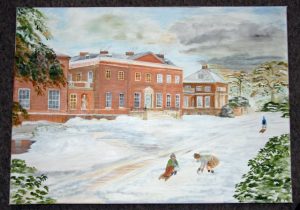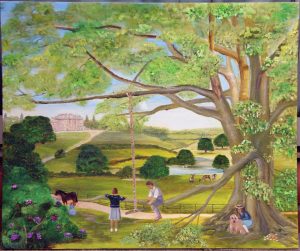Pictures of the Caldecott Community by Jean Mole.
The sirens screamed and the bombs whistled overhead as my grandmother ran with me in her arms to the air-raid shelter. It was 1942 I was a few months old, my mother was in prison for shoplifting and child neglect and my father was mentally ill in “The County Asylum”. Having raised twelve children of her own, my beloved gran was unable to cope with me for long and I was removed to hospital where I remained for seven months, supposedly safe from the bombing and abuse of my mother. It was agreed that I should be fostered by my aunt and uncle and I would never be returned to my mother, or told the truth about my parents.
By 1950 at seven years of age I was rebellious, described as “impossible to manage” by my foster parents spending more time at my gran’s house than with them. By now they had two children of their own and I felt unloved and unwanted.. I screamed and shouted, day and night.
The same year my father died in hospital and his body was brought home to lie in my gran’s front room. I believed he was my uncle, and could not understand why I had to kiss him every morning and at bedtime. I led the funeral procession, and threw flowers into the grave. I said goodbye for ever without knowing to whom.
As I became ever more difficult to control I was referred to The Maudsley Hospital in London. There I was assessed as in need of prolonged psychiatric and social work help with an urgent recommendation that I should be removed from the foster parents and live where I could experience safety and stability – The Caldecott Community. (Caldecott).
Located in a magnificent country mansion in Kent, South East England, Caldecott had grown from a nursery in London in 1911 to an innovative therapeutic environment headed by Leila Rendel its founder.. Formally registered as a school,
It offered a place of safety to distressed children from many backgrounds with the opportunity to grow and take a place in the world.. This was well before the recommendations of The Report of The Care of Children Committee (Curtis 1946) which insisted that Children’s Homes should serve as “places of safety and refuge” for children needing assessment, care and protection.. In 1947 with the help of The Nuffield Foundation Caldecott set up the first reception and assessment centre with the intention of providing evidence and experience for Local Authorities
Prior to this Children’s Homes were mainly provided by Voluntary Organisations such as Barnardo’s and The Children’s Society whereas Leila Rendel, along with Barbara Docker Drydsale of The Mulberry Bush in Oxford proposed a much wider and therapeutic response – the first of the Children’s Therapeutic Communities.
Writing at the time Miss Leila was clear – “It is useless to camouflage a children’s home or foster home as a “home from home”. that it could never be. For these children of misfortune there could be no adequate substitute”. I was fortunate to be one of the 195 children referred to New House for assessment in 1950, moving on to the nearby main house Mersham-le -Hatch in the same year.
Its true The Caldecott environment was never “homely”. That was its joy and salvation for children like me who felt out of place in a conventional family .It could cope with our impulse to break out, to run away, to act out feelings of anger and distress, which could not be contained in a box. We needed to be able to breathe, and do all these things without fear of sanctions, to be understood and cared for whatever we did. The Community met these needs exactly.
We had space outside and in to express ourselves, through education, art, literature,music,poetry, sport, work in the garden, with horses ,on bikes, hitch hiking, youth hostelling, camping and making friends, sometimes for life, The discipline, timekeeping, rituals and continuity created the sense of safety
All of this was a far cry from the suffocation I experienced in the domestic “family environment” . Although my foster parents were blood relatives, I had nothing in common with them, and re-acted against their attempts to control me. To be fair it was post war London, extreme poverty and uncertainty, and I had somehow inherited the streak of madness that came from both my parents.
At first we were educated in Caldecott’s own Nursery and Primary Schools, and at eleven we joined the local day Schools as appropriate, Secondary Modern, Grammar, Convent, depending on ability and returning at night to our secure base.
Our involvement in these schools ensured we were not isolated. from the local community. How I hated the school holidays, when three times a year we had to return home, There I was teased, bullied and ridiculed and could not wait for time to go back to Kent.
During my eight years at Caldecott I thrived on the environment, the opportunities for self expression, especially through Music and Drama, and learned how to manage my uncontrollable temper, night fears and dreams, and attempted self destruction. I responded to the discipline which was reasonable and fair (not hysterical as at home), and the routine of regular meals, clean clothes, and feeling of being important to my peers and those around me. I was rewarded appropriately for success, and my failures were understood . It did not matter that affection was not overt, this would have frightened me, and many others, who had already learned to distrust adults at an early age. The sense of belonging was most important.
Bearing in mind that this was the early days of such pioneering approaches to child care, the proposals for continuing after care as envisaged by Caldecott did not materialise as clearly as the assessment and therapeutic living and although individual members of staff made great efforts to maintain contact. – indeed some of them still do – it was a very different world and climate, and others returned to the families from which they had been rescued, and had to sink or swim. There was a standing invitation to return to Caldecott as a visitor from time to time at re-unions, but this did not appeal to many, who disappeared off the radar in a short time.
Returning to the family home at the age of 16 was a very great challenge for me, as I did not fit, did not want to fit, and soon started to experience again the anger and frustration of my early childhood. Within months I was literally thrown out into the snow with nowhere to go but now I had learned enough skills to survive, became independent, and never returned to live with the family again.. It would be good to record that I lived “happily ever after” but some of the damage caused by the circumstances of my birth, the time and place, left scars which have never healed. Only in recent years have I fully come to understand the truth about my background and parentage, and this has helped a great deal in resolving some of the questions. The sense of loss and abandonment has never left me.
In the 1950’s Leila Rendel clearly identified not only the needs of the children at the time but in the future, setting out clearly a strategic plan for the future with children always at the heart. An individual response, assessment, fostering where appropriate, a variety of facilities ranging from small family homes urban and rural, to larger creative environments for those children who needed more space, The kind of shelter that would satisfy and not be met with anger and rejection by the child. Last but not least ongoing support and aftercare for as long as needed.
Following Miss Leila’s death in 1968, Caldecott attempted to adapt to what her successors and pressure from potential funders saw as the progressive approach to child care, living in smaller groups, more professional staff, more emphasis on return to the family and family involvement. Government and Local Authority politics and finance rather than philosophy dominated decisions about the nature of residential care for children and in time even the small group homes have given way to an overall emphasis on fostering and rehabilitation. The Caldecott Community was not exempt from this pressure, moving from its original location in the year 2000 and becoming a restructured organisation (The Caldecott Foundation) with a more specialist and individual response.
What all of this overlooks was clearly identified by Curtis, Rendel, Docker Dyrdale, Wills and others. They believed that some children are so hurt, so damaged, so vulnerable, that its an escape from family life not a return to it that’s needed.. For those that cannot return to families and for whom fostering is not appropriate, skilful preparation for an independent life in the community is a vital part of any programme. Research for the NSPCC has shown that about half of the children who go into care because of abuse or neglect suffer further abuse if they return home and and later have to return to care.
Its hard for me to be objective given my own experience, but I believe that those organisations that have developed the concept of a more personal approach in smaller living units, while retaining the concept of community have been and are the most successful. Policy alone cannot re-create the vision of the charismatic Individuals who made a unique contribution to the care of children from which so many have had the benefit.
Some of us have to leave the nest before we learn to fly.
Can we be sure someone will always be there to break the fall?
Cyril Ives
Mersham-Le-Hatch 1950-1958
For Reference:
Report of the Care of Children Committee – Curtis HMSO 1946
The Child of Misfortune – Leila Rendel 1952
Deprived Children – The Mersham Experiment Hilda Lewis 1954
The Caldecott Community Association : www.caldecott.org.uk
Supporting children and families returning home from care – counting the costs
Centre for Child and Family Research 2014 (for NSPCC)
Re-uniting looked after children with their families Behalf N (2006)
Therapeutic Living with Other Peoples Children PETT Archive 2012
The Mulberry Bush Approach
John Tuberville www.goodenoughcaring.com July 2015
Reflections on the evolution of The Mulberry Bush School and Organisation
John Diamond www.goodenoughcaring.com July 2015
The Mulberry Bush School Ofsted Report January 2016.


